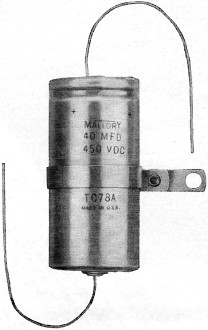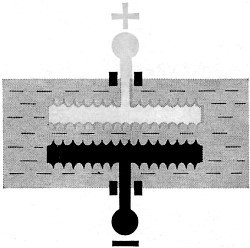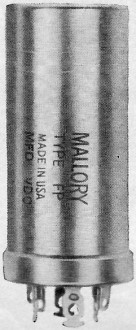|
February 1969 Electronics World
 Table of Contents
Table of Contents
Wax nostalgic about and learn from the history of early electronics. See articles
from
Electronics World, published May 1959
- December 1971. All copyrights hereby acknowledged.
|
Akin to how the
National Company ran a long series
( a couple hundred altogether) of infomercial type ads in the ARRL's QST magazine
from the 1930s through the 1950s, Mallory had its "Tips for Technicians" run in Electronics
World (and maybe other electronics magazines of the era). Being a major capacitor manufacturer,
its ads featured brief tutorials on various types of capacitors, their characteristics, and
how they should be used in circuits - both for new design and when replacing capacitors in
existing equipment.
Here is a May 1967 Tips for
Technicians, a February 1969
Tips for Technicians,
and a May 1969 Tips for
Technicians.
Why some filter capacitors develop hum and some don't.


 Aluminum electrolytic capacitors are widely used as filters
in DC Power Supplies. This is because of their large capacitance in relatively small size.
All in all, they do an efficient job of reducing ripple (hum) to acceptable levels.
Aluminum electrolytic capacitors are widely used as filters
in DC Power Supplies. This is because of their large capacitance in relatively small size.
All in all, they do an efficient job of reducing ripple (hum) to acceptable levels.
However, all electrolytic capacitors are not alike. This is often why some types seem to
allow hum to rise to objectionable levels more quickly than do others. In order to understand
why, we must investigate actual construction methods.
As you know, electrolytics are basically made by depositing a film of aluminum oxide on
aluminum foil to form the positive anode. The oxide is the dielectric. A semi-liquid electrolyte
surrounds the anode and is actually the negative cathode. In order to connect this semi-liquid
cathode to a terminal, a second piece of aluminum foil is used. This is often called the cathode,
but it is not. It is actually only the cathodic connection. (The preceding describes a "polarized"
electrolytic capacitor.)
 When high ripple currents are applied to polarized electrolytics,
a thin oxide film forms on the so-called "cathode". It begins to assume the characteristics
of a second anode. This in turn, has the same effect as placing two capacitors in series.
Consequently, overall capacitance is reduced. Inevitably hum increases.
When high ripple currents are applied to polarized electrolytics,
a thin oxide film forms on the so-called "cathode". It begins to assume the characteristics
of a second anode. This in turn, has the same effect as placing two capacitors in series.
Consequently, overall capacitance is reduced. Inevitably hum increases.
This action is especially noticeable in electrolytics which use plain foil as the" cathode".
This is simply because the oxide builds up over a relatively small area.
Mallory avoids this problem by etching the" cathode" on electrolytics. As a result, oxide
build-up is spread over a vastly increased area. Therefore, ripple currents are maintained
at very low levels for very long time periods.
Of course etched "cathodes" cost a lot more to make. But you get them from Malloy at no
extra cost.
Meanwhile, see your local Franchised Mallory Distributor for capacitors, resistors, controls,
switches, semiconductors, and batteries. Or write Mallory Distributor Products Company, a
division of P. R. Mallory & Co. Inc., Indianapolis, Indiana 46206.
Don't Forget To Ask 'Em "What else needs fixing?"
Circle No. 91 On Reader Service Card

Posted November 17, 2017










 Aluminum electrolytic capacitors are widely used as filters
in DC Power Supplies. This is because of their large capacitance in relatively small size.
All in all, they do an efficient job of reducing ripple (hum) to acceptable levels.
Aluminum electrolytic capacitors are widely used as filters
in DC Power Supplies. This is because of their large capacitance in relatively small size.
All in all, they do an efficient job of reducing ripple (hum) to acceptable levels.  When high ripple currents are applied to polarized electrolytics,
a thin oxide film forms on the so-called "cathode". It begins to assume the characteristics
of a second anode. This in turn, has the same effect as placing two capacitors in series.
Consequently, overall capacitance is reduced. Inevitably hum increases.
When high ripple currents are applied to polarized electrolytics,
a thin oxide film forms on the so-called "cathode". It begins to assume the characteristics
of a second anode. This in turn, has the same effect as placing two capacitors in series.
Consequently, overall capacitance is reduced. Inevitably hum increases. 
